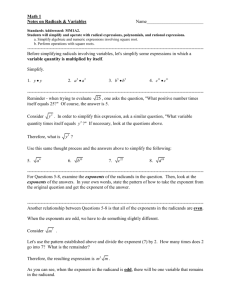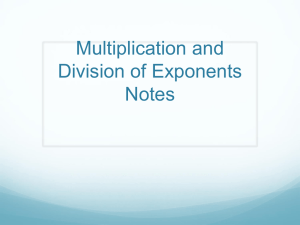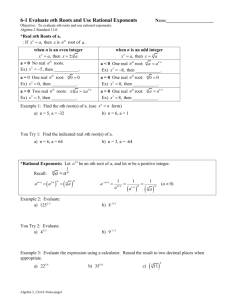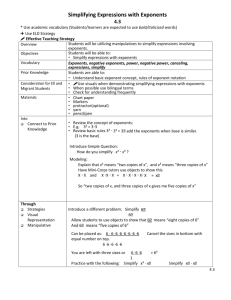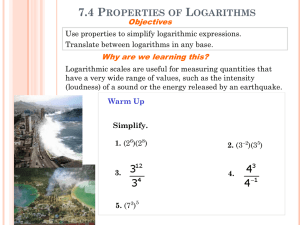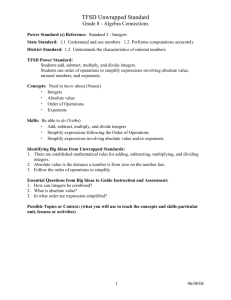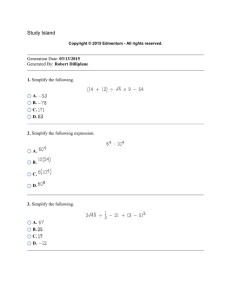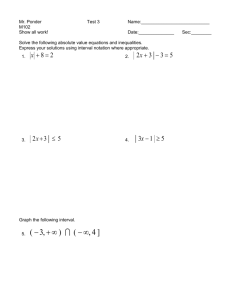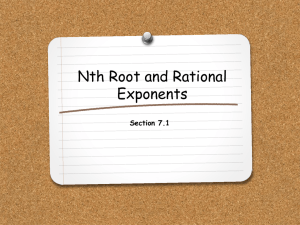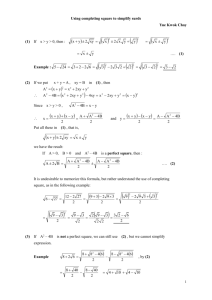Principal nth Root of a: The principal nth root of a number a, symb
advertisement
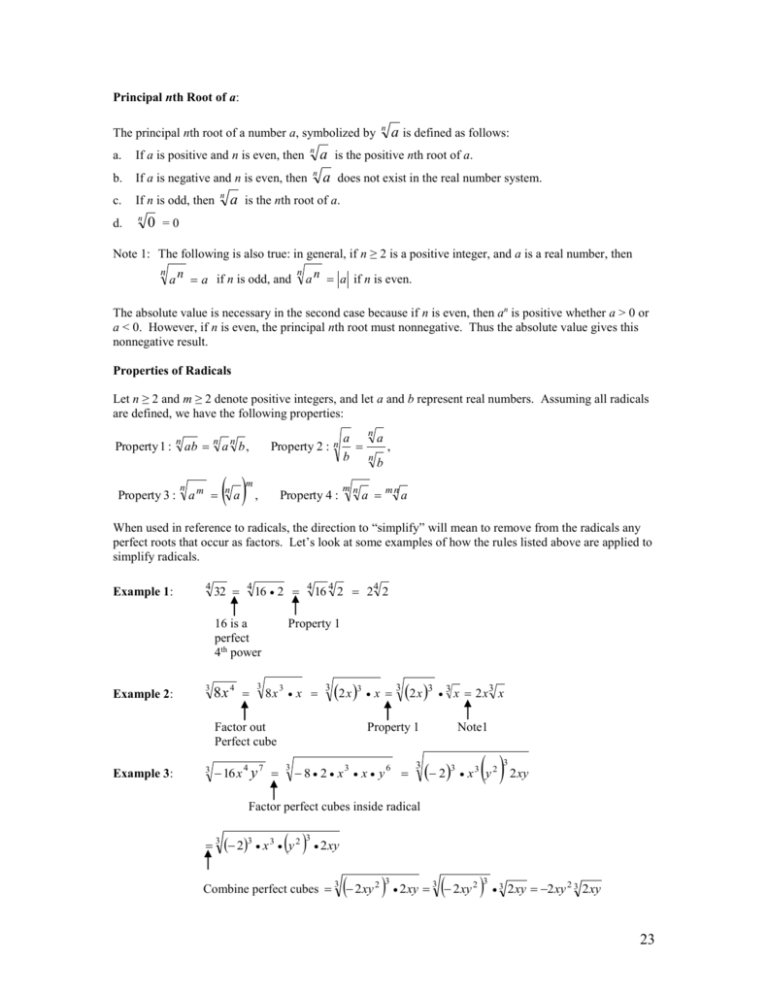
Principal nth Root of a: The principal nth root of a number a, symbolized by n a. If a is positive and n is even, then b. If a is negative and n is even, then c. If n is odd, then n d. n n n a is defined as follows: a is the positive nth root of a. a does not exist in the real number system. a is the nth root of a. 0 =0 Note 1: The following is also true: in general, if n ≥ 2 is a positive integer, and a is a real number, then n a n a if n is odd, and n a n a if n is even. The absolute value is necessary in the second case because if n is even, then an is positive whether a > 0 or a < 0. However, if n is even, the principal nth root must nonnegative. Thus the absolute value gives this nonnegative result. Properties of Radicals Let n ≥ 2 and m ≥ 2 denote positive integers, and let a and b represent real numbers. Assuming all radicals are defined, we have the following properties: a na Property 2 : n , b n b Property 1 : n ab n a n b , Property 3 : n am n a m , Property 4 : mn a mn a When used in reference to radicals, the direction to “simplify” will mean to remove from the radicals any perfect roots that occur as factors. Let’s look at some examples of how the rules listed above are applied to simplify radicals. Example 1: 4 32 4 16 2 16 is a perfect 4th power Example 2: 3 8x 4 3 4 16 4 2 2 4 2 Property 1 8x 3 x 3 2 x 3 x 3 2 x 3 3 x 2 x3 x Factor out Perfect cube Example 3: 3 4 16 x y 7 Property 1 3 3 6 82 x x y 3 Note1 23 x 3 3 y 2 2 xy Factor perfect cubes inside radical 3 23 x 3 y 2 3 2 xy Combine perfect cubes 3 2 xy 2 3 2 xy 3 2 xy 2 3 3 2 xy 2 xy 2 3 2 xy 23 Two or more radicals can be combined, provided that they have the same index and the same radicand: in n a : n is the index, and a is the radicand. 4 27 8 12 3 4 9 3 8 4 3 3 4 9 3 8 4 3 3 Example 4: 43 3 82 3 3 12 3 16 3 3 12 16 1 3 3 3 Exercise 4.1: In problems 1 – 20, simplify each expression. 1. 30 6. 4 5 11. 3 6 3 4 16. 3 2 2. 32 3. 4 2 4. 32 7. 30 2 3 8. 23 2 0 9. 1 2 3 2 12. 4 2 4 3 13. 3 3 17. 23 32 18. 2 3 2 82 43 14. 23 3 2 5 3 35 22 9 2 19. 2 5. 2 3 10. 3 2 2 3 2 15. 3 20. 6 5 3 2 1 2 In problems 21 – 56, simplify each expression so that all exponents are positive. Whenever an exponent is negative or 0, we assume the base does not equal 0. 21. x0 y 2 26. 8x 3 31. 36. 41. 45. 49. 2 x 2 y 2 x 1 y 23. x 2 y 24. x4 y0 25. 8x 27. 4 x 1 28. 4 x 1 29. 5x 0 30. 5x 0 33. x 1 y 1 34. x 2 y 3 x 35. 38. xy 39. x 1 y 2 40. 32. xy 4 2x 3 22. 1 37. x 1 y 2 z xy 2 4x 5y 42. x 2 yz 3 x 2 x 2 y 2 3 x 1 4 y 1 x 2 y 46. 2 50. 2 3 x 2 yz 2 x 4 y 3 z x 1 y 1 x 1 y 1 5x 2 6 y 2 2 2 43. 47. 3 23 x 4 yz 2 3 2 xy 3 z 4 x y 2 y x 44. 4 xy 48. 1 2 51. xy x 1 y 1 x 1 y 1 4 x 2 yz 1 52 x 4 y 2 z 2 2 x2 y3 3 2 y x x 2 y 3xy 2 x y 1 2 52. 1 3 24 53. 3 x y2 2 x2 y 54. 2x 3y 2 1 2 55. y3 x y2 2 x y x y 2 3 y 2 1 56. 3 2 3 Exercise 4.2: In problems 1 – 10, find the value of each expression. 1. 4 2. 16 3. 1 9 4. 1 25 5. 25 9 6. 9 16 7. 25 9 8. 9 16 9. 2.42 10. 6.22 In problems 11 – 21, simplify each expression. 11. 12 12. 8 13. 15. 9 16 16. 25 4 17. 21. 19. 32 20. 2 23. 28 14. 3 24 8 9 18. 12 25 6 12 22. 3 27 4 27 7 2 5 4 5 24. 3 7 2 7 In problems 25 – 30, perform the indicated operation(s) and simplify, 25. 3 2 4 8 26. 9 6 2 24 28. 3 12 2 3 5 2 29. 2 3 3 2 27. 2 12 3 6 5 27 30. 4 5 2 5 Exercise 4.3: In problems 1 – 28, simplify each expression. Assume all variables are positive when they appear. 1. 3 81 2. 4 32 3. 5. 3 73 6. 4 64 7. 9. 4 x 12 y 8 10. 5 x 10 y 5 11. 3 3 16 x 4 4. 32 x 3 9x 8. x9 y7 xy 3 12. 27 x 3 3 x 8x 4 3xy 2 81 x 4 y 2 25 13. 3xy 3 2 x 2 y 17. 3 6x y 3 18. 3 3 3 25. 2 x6 3 x 2 12 x 15. x 2 y 3 125 x 3 4 5 9 21. 9x 5 14. 36x 3 8x y 2 9x y 22. 3 10 23. 26. x6 27. 4 3 4 19. 4 4 x8 3 9 20. 4 16 x 4 y 6 4 24. 4 5 3 5 x 20 x 3 16. 4 4 x8 2 3 3 28. 3 5 5 In problems 29 – 38, simplify each expression. 29. 34 2 24 2 4 2 30. 65 5 3 5 43 5 32. 54 3 2 12 27 33. 3 3 33 2 18 2 8 34. 93 24 3 81 8 x 3 3 50 x 2 x 5 , x 0 36. x 2 y 3x 9 y 4 25 y , x 0, y 0 16 x 4 y 3x3 2 xy 53 2 xy 4 38. 8 xy 25 x 2 y 2 3 8 x 3 y 3 , x 0, y 0 35. 37. 16 53 2 23 54 31. In problems 39 - 47, perform the indicated operation, and simplify the result. 39. 3 6 2 9 40. 5 8 3 2 42. 4 2 4 2 43. 3 7 3 2 7 2 45. 46. 3 3 4 4 2 x 1 , x 0 41. 9 3 9 3 44. 2 x 5 , x0 47. 4 4 2 4 3 4 6 3 2 x 1 3 Radical Exponents Our purpose in this section is to give a definition for "a raised to the power m/n,” where a is a real number and m/n is a rational number. However, we want the definition we give to ensure that the laws of exponents stated for integer exponents earlier remain true for rational exponents. For example, if the law of exponents r s 1 a n rs (a ) = a is to hold, then it must be true that n 1 n a n a1 a 1 That is, a n is a number that, when raised to the power n, is a. But this was the definition we gave of the 1 1 principal nth root of a earlier. Thus and we can state the following definition: 1 an a2 a 1 a3 3 a a4 4 a 1 If a is a real number, and n ≥ 2 is an integer, then a n n a , Example 1: (a) 1 42 4 2 provided n a exists. 1 (b) 27 3 3 27 3 26 Example 2: 1 82 (a) 82 2 1 16 3 (b) 3 16 23 2 1 n Note: Remember that if n even and a < 0, then a and a n do not exist, Here’s another definition: a m n If a is a real number and m and n are integers containing no common factors with n ≥ 2, then m an am n a m n , provided n a exists. Two comments about this last definition: 1. 2. The exponent must be in lowest terms and n must be positive. In simplifying the rational expression a m n , either n a m or a n m may be used, the choice depending on which one is easier to simplify. Generally, taking the root first, as in preferred. 3 4 3 Example 3: (a) 4 2 Example 4: (a) 32 5 2 4 (b) 8 3 23 8 32 2 5 2 2 6 1 4 8 3 3 (b) 4 4 4 2 m 4 4 3 a n m , is 24 16 23 8 m Based on the definition of a n , no meaning is given to a n if a is a negative real number and n is an even integer. The following examples illustrate the use of the laws of exponents to simplify certain expressions containing rational exponents. In these examples, we assume that the variables are positive. . Example 5: Example 6: 1 2x 3 2 y3 3 2 3 x3 y 4 2 x3 y 2 y3 1 2x 3 x 2 y 3 1 4 x 1 y 2 1 2 3 2 y3 3 y2 y2 3 3 8x 1 1 3 3 3 2x 2 x 2 3 x3 y 4 x 2 2 3 1 x 3 x 1 y 4 y 2 1 2 1 y2 1 1 x 3 y 4 1 1 1 x3 y4 27 Exercise 4.4: In problems 1 – 20, simplify each expression. 2 1. 83 2. 3 2 3 42 6. 64 11. 8 9 1 9 1 .5 16. 3 2 3 2 7, 9 12. 8 27 17. 3 1 27 3 3. 2 3 3 6 5 2 8. 25 13. 41.5 18. 4 6 3 4. 16 4 3 5. 16 2 9. 92 8 10. 27 3 8 14. 16 1.5 15. 1 4 19. 2 20. 3 2 2 1.5 5 4 8 In problems 21 – 26, simplify each expression. Express you8r answer so that only positive exponents occur. Assume that the variables are positive. 3 1 21. x4x4x 24. x y 4 3 9 4 1 2 3 1 1 4 22. x4x2x 25. x y xy 2 1 3 2 2 3 23. x y 26. xy 4 x 2 y 2 2 3 1 6 3 1 1 28
